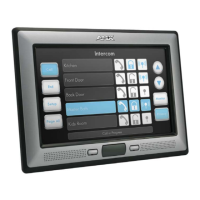Appendix C - URL Resources
203
NXD-1000Vi 10" Modero® Wall/Flush Mount Touch Panel with Intercom
Appendix C - URL Resources
Overview
A URL can be broken into several parts.
For example: the URL http://www.amx.com/company-info-home.asp.
This URL indicates that the protocol in use is http and that the information resides on a host machine named
www.amx.com.
The image on that host machine is given an assignment (by the program) name of company-info-home.asp
(Active Server Page).
The exact meaning of this name on the host machine is both protocol dependent and host dependent. The
information normally resides in a file, but it could be generated dynamically. This component of the URL is
called the file component, even though the information is not necessarily in a file.
A URL can optionally specify a port, which is the port number to which the TCP connection is made on the
remote host machine. If the port is not specified, the default port for the protocol is used instead. For example,
the default port for http is 80.
An alternative port could be specified as: http://www.amx.com:8080/company-info-home.asp.
Special Escape Sequences
The system has only a limited knowledge of URL formats in that it transparently passes the URL information
onto the server for translation. A user can then pass any parameters to the server side programs such as CGI
scripts or active server pages. However; the system will parse the URL looking for special escape codes. When
it finds an escape code it replaces that code with a particular piece of panel, button, or state information.
For example, "http://www.amx.com/img.asp?device=$DV" would become
"http://www.amx.com/img.asp?device=10001".
Other used escape sequences include:
Any legal HTTP syntax can be used.
Escape Sequences
Sequence Panel Information Sequence Panel Information
$DV Device Number $BY Y Resolution of current button
$SY System Number $BN Name of button
$IP IP Address $ST Current state
$HN Host Name $AC Address Code
$MC Mac Address $AP Address Port
$ID Neuron ID $CC Channel Code
$PX X Resolution of current panel mode/file $CP Channel Port
$PY Y Resolution of current panel mode/file $LC Level Code
$BX X Resolution of current button $LP Level Port

